Twelve births per thousand population
In 2021, a total of 170,370 registered live births were registered in the National Capital Region (NCR) by place of occurrence. The number of registered live births to mothers with a usual place of residence in NCR reached 160,946, equivalent to a crude birth rate (CBR) of 11.5 or around 12 births per thousand population.1 The number of registered births from 2012 to 2021 generally decreased. A decrease of 34.8 percent in the registered live births was noted in the past ten years, from 246,994 in 2012 to 160,946 in 2021. The highest rate of decline was noted in 2021 with 19.1 percent. (Figure 1 and Table 1). On average, 441 babies were born daily, which translates to 18 babies per hour, based on the number of registered live births to mothers with a usual residence in NCR. (Table 1)
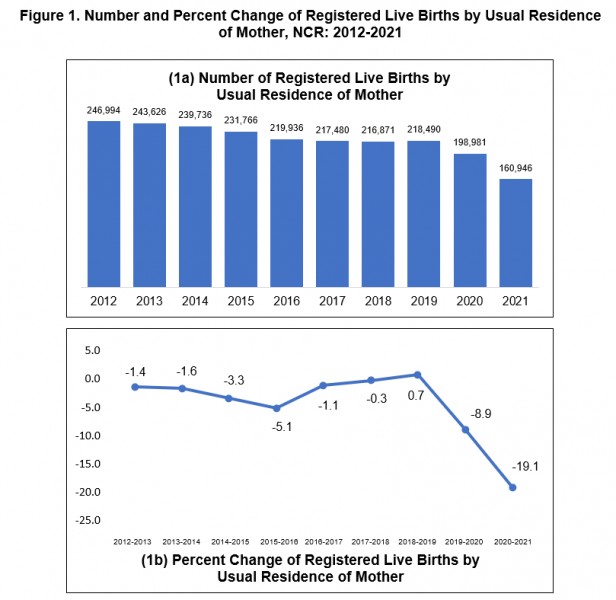
More male babies were born than females
More male babies were born (83,552 or 51.9% share) than female babies (77,394 or 48.1% share) in 2021, resulting in a sex ratio at birth of 108 males per 100 females to mothers with a usual residence in NCR. The city of Malabon posted the highest sex ratio with 113 males per 100 females. (Figure 2 and Table 2)

More than half of the registered live births occurred in three cities of NCR
The City of Manila registered the highest number of live births with 40,086 (23.5% share) followed by Quezon City with 37,581 (22.1% share) and the City of Caloocan with 15,391 (9.0% share). These three cities' combined registered live births comprised 54.6 percent of the total live births in NCR. Meanwhile, the Municipality of Pateros reported the least number of live births with 918 (0.5% share). (Figure 3 and Table 2)
Births occurring in NCR exceed births to mothers residing in the region
Registered births that occurred in NCR exceeded births to mothers residing in the region by 9,424. Five cities and the municipality of Pateros reported more birth occurrences than registered births from mothers residing in the respective cities/municipality. The City of Manila posted the largest difference between registered births and births to mothers residing in the city with 17,632 which is 44 percent of the births that occurred there. On the other hand, the City of Caloocan with 15,391 (9.0% share) registered births and 21,597 (13.4% share) births from mothers residing in the city topped among the eleven cities that reported lesser registered births than births from its residents. (Figure 3)

Most number of births registered in September
In 2021, most registered births occurred in September with 17,110 (10.0% share) followed by the months of October with 16,835 (9.9% share) and August with 16,024 (9.4% share). On the other hand, the month of February had the least number of births with 10,565 (6.2% share). (Figure 4 and Table 3)
In terms of daily average, September recorded the highest with an average of 570 births per day, which translates to 24 births per hour. On the other hand, February had the lowest daily average number of births with 377, equivalent to 16 births per hour.
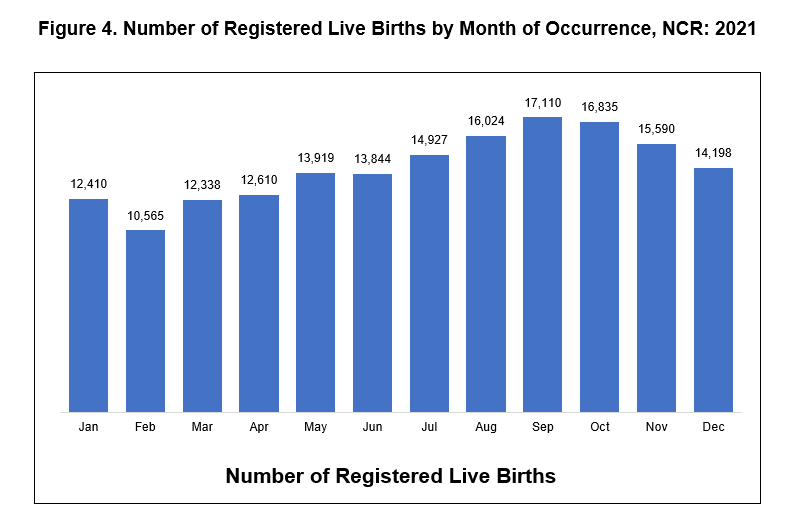
96 percent of birth deliveries in NCR were medically attended to and delivered in health facilities
Of the total number of births in NCR, 96.0 percent (163,510) were attended by health professionals (physicians, midwives, or nurses). Most births were delivered by physicians (72.3% share) followed by midwives (23.4% share). On the other hand, 4.0 percent of births were delivered by traditional birth attendants. (Figure 5 and Table 4)
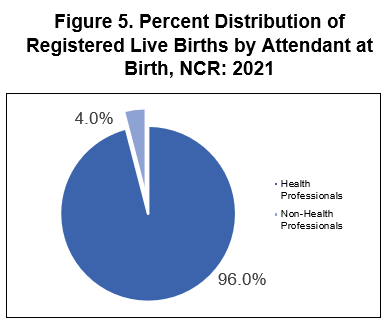
In terms of place of delivery, 94.6 percent (161,179) of births in NCR were delivered in health facilities (either a hospital, birthing clinic, lying-in, outpatient care center, and the like), 5.4 percent (9,191) were delivered at home and other locations. (Figure 6 and Table 4)
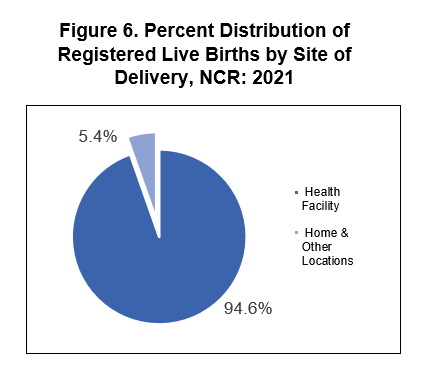
About nine in ten newborn babies weighed more than 2,500 grams
The birth weight serves as a measure of the nutritional status of newborns. The World Health Organization defines low birth weight as a weight less than 2,500 grams (5.5 lbs) at birth. Of the total number of newborn babies, 87.0 percent were above the defined low birth weight. (Figure 7 and Table 5)
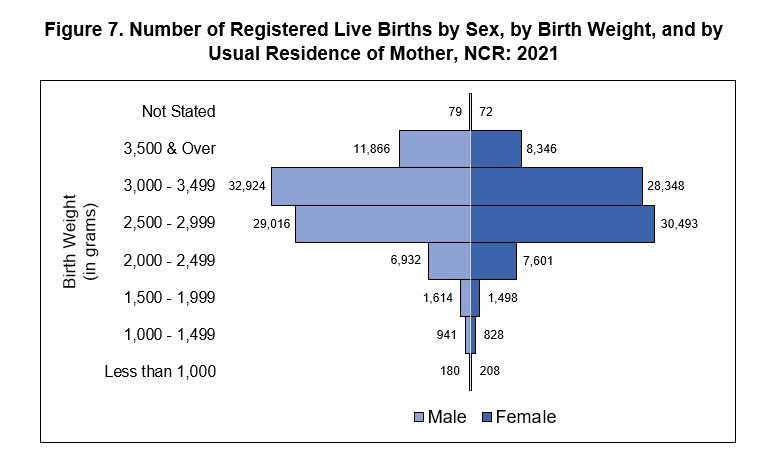
Two in every three babies were born to unwed mothers
Of the total 160,946 registered live births to mothers residing in the region, 111,296 or 69.2 percent were born out of wedlock. This translates to two in every three babies born to unwed mothers residing in NCR in 2021. Among sixteen cities and a municipality in NCR, Quezon City has the highest percentage of babies born to unwed mothers with 23,467 or 21.1 percent. (Figure 8 and Table 6)
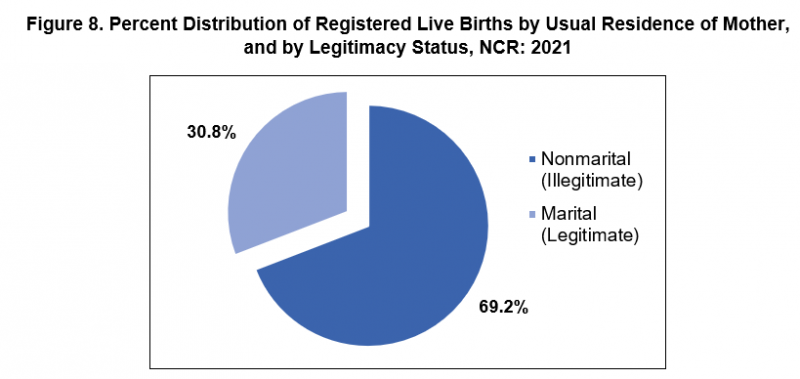
Around 70 percent of births are nonmarital (illegitimate)
Of the total registered live births, 69.2 percent (111,296) are conceived and born out of a valid marriage. Mothers aged 25-29 years had the highest number of nonmarital babies in 2021, contributing 32,896 of the total nonmarital births that year. (Table 7)
By age group of mothers, the highest proportion of nonmarital births was to adolescent mothers aged under 15. Of the total number of babies born to adolescent mothers aged under 15, 99.1 percent (233) were nonmarital. This was followed by births to adolescent mothers aged 15-19 years with 98.3 percent (11,915). On the other hand, the least proportion of nonmarital babies (36.4%) were mothers aged 50 years old and over. (Figure 9 and Table 7).
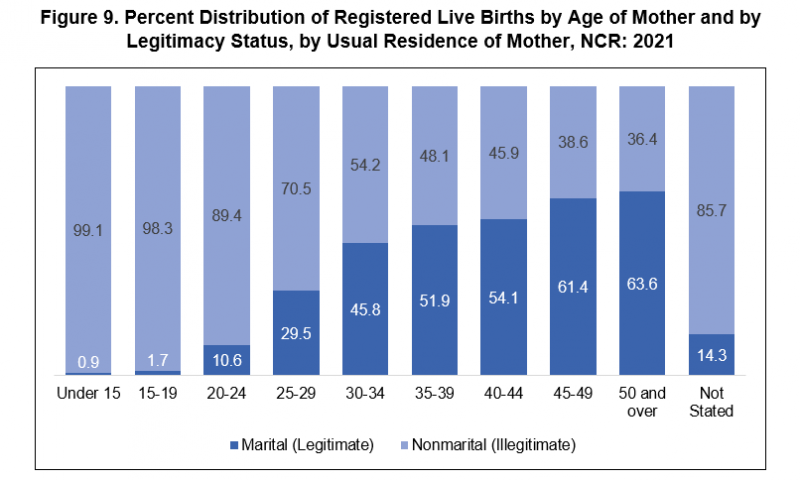
About 94 percent were registered on time
Timely registration refers to the registration of the birth within 30 days of occurrence. In 2021, 94.2 percent of live births to mothers residing in NCR were registered on time while 5.8 percent were registered late. The City of Mandaluyong recorded the highest percentage of timely registration with 98.0 percent while the City of Parañaque recorded the lowest percentage with 85.2 percent.
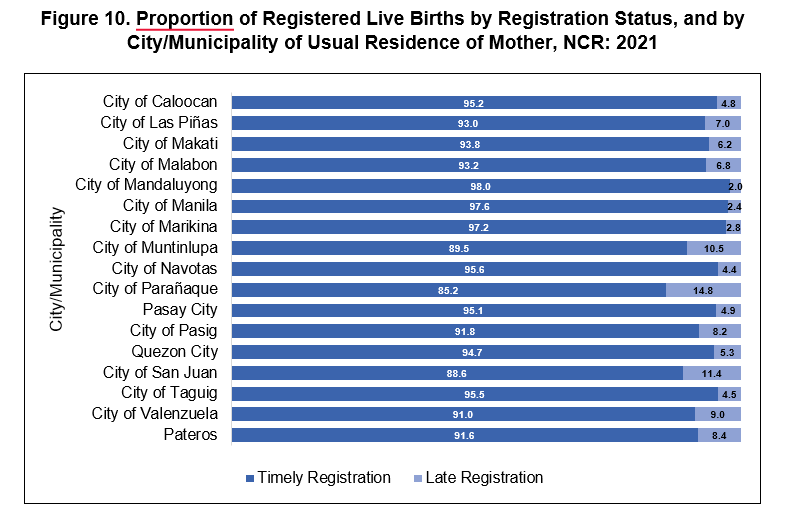
SGD.
PACIANO B. DIZON
Regional Director
Technical Notes
Vital statistics are derived from information obtained at the time when the occurrences of vital events and their characteristics are inscribed in a civil register.
Vital acts and events are the births, deaths, fetal deaths, marriages, and all such events that have something to do with an individual’s entrance and departure from life together with the changes in civil status that may occur to a person during his lifetime. Recording of these events in the civil register is known as vital or civil registration and the resulting documents are called vital records.
Live Birth is a complete expulsion or extraction from its mother of a product of conception, irrespective of the duration of the pregnancy, which after such separation, breathes or shows any other evidence of life, such as the beating of the heart, pulsation of the umbilical cord, or definite movement of the voluntary muscles, whether or not the umbilical cord has been cut or the placenta is attached: each product of such a birth is considered live born.
Crude Birth Rate (CBR) refers to the number of live births per 1,000 mid-year population.
Sex Ratio refers to the number of males per one hundred females.
Usual Residence refers to the place where the person habitually or permanently resides.
Place of Occurrence refers to the place where the vital event took place.
Marital (Legitimate) children conceived or born during the marriage of the parents. Children born after one hundred and eighty days following the celebration of the marriage, and before three hundred days following its dissolution or the separation of the spouses shall be presumed to be legitimate. (Art. 225, Civil of the Philippines).
Nonmarital (illegitimate) children conceived and born out of a valid marriage unless otherwise provided in the Family Code (Art. 165, F.C.).
Attachments:
- Table 1. Number and Percent Change of Registered Live Births by Usual Residence of Mother, National Capital Region: 2012-2021
